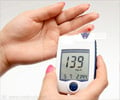New research suggests that differences among racial groups must be taken into account when using hemoglobin A1C levels to diagnose and monitor diabetes.

"There have been several studies indicating that hemoglobin A1C levels are consistently higher in blacks than in whites, even though underlying blood sugar levels are similar," said lead author Yusuke Tsugawa, MD, MPH, a primary care fellow at Beth Israel Deaconess Medical Center. "We looked at the data to determine if a higher diagnostic cutoff of A1C level should be used to diagnose diabetes in blacks than in whites, or if there should be a single cutoff for all races."
Diabetes has been historically diagnosed based on blood glucose tests, but in 2010 the International Expert Committee recommended adding hemoglobin A1C because it is a more reliable test that reflects average blood sugar over the past two to three months.
In line with the Expert Committee''s recommendation, the World Health Organization and the American Diabetes Association subsequently adopted a hemoglobin A1C level of 6.5 percent or higher as a new diagnostic criterion for diabetes. For people who do not have diabetes, a normal hemoglobin A1C level is around 5 percent.
Given the evidence of naturally higher A1C levels in black people, the researchers expected to also find a delayed development of retinopathy in blacks compared to whites. Instead, the data showed that the A1C level where the risk of retinopathy begins to increase was paradoxically lower in black people compared to white people.
"Our study results show that the risk of diabetic retinopathy is higher for blacks at any given hemoglobin A1C level between 5 percent and 7 percent, and that the higher risk at a hemoglobin A1C level of 5.5 to 5.9 percent for blacks was comparable to the risk at a hemoglobin A1C level of 6.0 to 6.4 percent for whites," said Tsugawa. "This indicates that black people may be more vulnerable to high A1C status than whites."
Advertisement
"Globally, diabetes is one of our most prevalent public health concerns, so this could have important health care delivery and health care policy implications" said Tsugawa. "It may be appropriate for doctors to more closely monitor for early diabetic complications for their black patients than for their white patients and black patients with diabetes may benefit from retinal exams at an earlier stage of their disease."
"And if future studies show that setting race-specific cutoff points for A1C is cost-effective, we might be able to trim healthcare expenditure in diabetes by targeting interventions toward specific, high-risk black populations," said Tsugawa.
Advertisement
"Another unanswered question is the underlying mechanism as to why A1C levels are consistently higher in blacks than whites," said senior author Christina Wee, MD, MPH, Associate Section Chief for Research in the Division of General Medicine and Primary Care at BIDMC. "This may be due to biological differences or socio-behavioral differences including disparities in access to health and preventive care, which often lead to dramatically different policy implications. We''re unclear on the cause, but we''re certain it warrants further investigation."
Other study authors include Kenneth J. Mukamal, MD, MPH, Roger B. Davis, ScD and William C. Taylor, MD from Beth Israel Deaconess Medical Center.
Tsugawa is supported by the Shigeaki Hinohara, MD Primary Care Fellowship at BIDMC, the Joint Japan/World Bank Graduate Scholarship Program and the St. Luke Life Science Institute in Tokyo, Japan. Davis is supported by Harvard University and the National Institutes of Health. Wee is supported by a midcareer mentorship award from the National Institutes of Health.
Beth Israel Deaconess Medical Center is a patient care, teaching and research affiliate of Harvard Medical School, and currently ranks third in National Institutes of Health funding among independent hospitals nationwide. BIDMC is clinically affiliated with the Joslin Diabetes Center and is a research partner of Dana-Farber/Harvard Cancer Center. BIDMC is the official hospital of the Boston Red Sox. For more information, visit www.bidmc.org.
Source-Newswise














